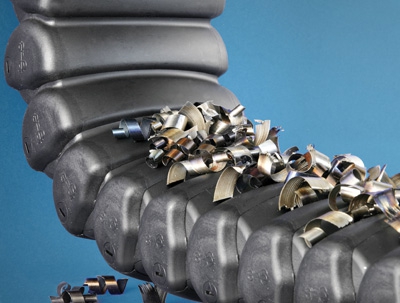
If moving cables in the workspace of lathes, milling and sawing machines need protecting, cable carriers must be chip tight, while simultaneously guiding the cables with low abrasion. For this purpose, igus has developed its first foldable plastic energy tube, the R68 in the Energy Chain System line of cable carriers. This latest energy tube offers comprehensive protection against chips of any size.
To make claims about the tightness of energy tubes, those tubes must first be extensively tested. For over 10 years, igus has continually tested energy tubes in the igus laboratory in Cologne, Germany. The igus test series is done under real environmental conditions for the most accurate simulation outside of the application itself. igus has developed a standardized test to move energy tubes like the R68 over 100,000 double strokes. At the same time, a defined load of chips of different sizes are periodically poured over the tube, again and again. At the end of the cycles, testers analyze how many grams of chips were allowed into the interior of the tube. The R68 energy tube was proven to allow only 0.23 grams of chips in over 100,000 double stokes with a feed of 1,000 grams of metal chips, equal to only .023 percent chip allowance.
Comparative tests with other manufacturers' cable carriers show a much higher volume of chips allowed into the tube. The reason behind the better result from the R68 energy tube is its rounded profile. On its smooth and convex outer contour, the chips simply slide off the surface of the tube. The RX tube offers the best protection against chips due to its smooth contours and especially tight production tolerances: no chips got between the stoppers during the test, crucial to prevent changing the bend radius of the tube, which could disrupt or even inhibit the system from moving properly.
Contact Details
Related Glossary Terms
- feed
feed
Rate of change of position of the tool as a whole, relative to the workpiece while cutting.
- gang cutting ( milling)
gang cutting ( milling)
Machining with several cutters mounted on a single arbor, generally for simultaneous cutting.
- milling
milling
Machining operation in which metal or other material is removed by applying power to a rotating cutter. In vertical milling, the cutting tool is mounted vertically on the spindle. In horizontal milling, the cutting tool is mounted horizontally, either directly on the spindle or on an arbor. Horizontal milling is further broken down into conventional milling, where the cutter rotates opposite the direction of feed, or “up” into the workpiece; and climb milling, where the cutter rotates in the direction of feed, or “down” into the workpiece. Milling operations include plane or surface milling, endmilling, facemilling, angle milling, form milling and profiling.
- sawing
sawing
Machining operation in which a powered machine, usually equipped with a blade having milled or ground teeth, is used to part material (cutoff) or give it a new shape (contour bandsawing, band machining). Four basic types of sawing operations are: hacksawing (power or manual operation in which the blade moves back and forth through the work, cutting on one of the strokes); cold or circular sawing (a rotating, circular, toothed blade parts the material much as a workshop table saw or radial-arm saw cuts wood); bandsawing (a flexible, toothed blade rides on wheels under tension and is guided through the work); and abrasive sawing (abrasive points attached to a fiber or metal backing part stock, could be considered a grinding operation).






